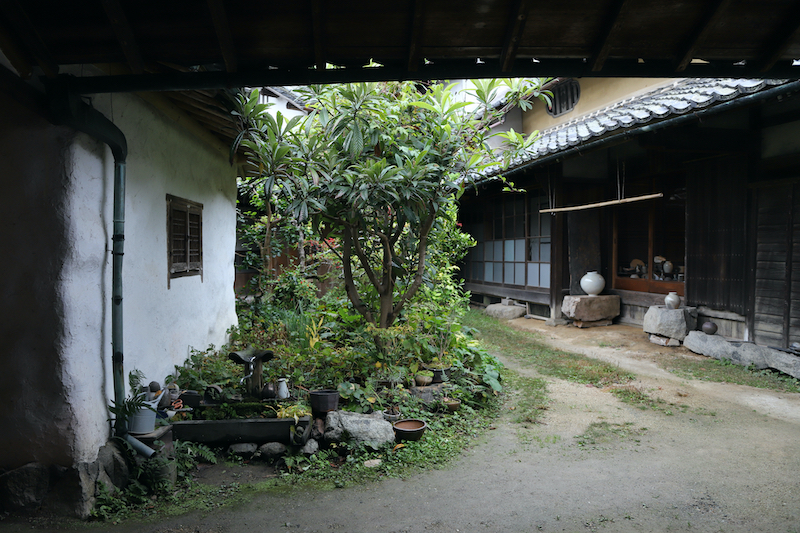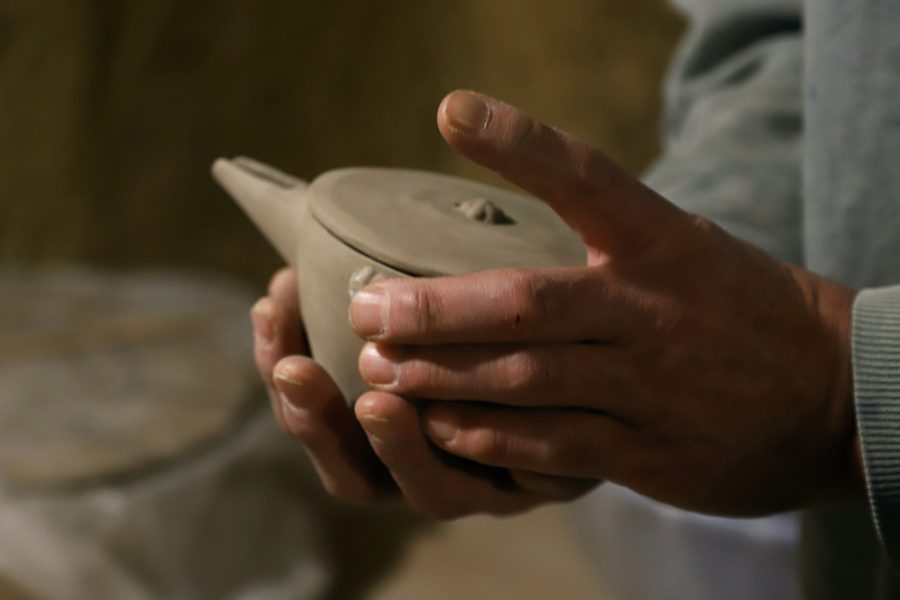
奈良県高市郡明日香村 陶芸家 タナカシゲオAsuka Village, Takaichi District, Nara Prefecture
Shigeo Tanaka, Ceramicist
奈良県高市郡明日香村の周辺、万葉集に最も数多く詠まれてきた飛鳥地方。古墳時代より来訪神(マレビト)とされ我が国に技術や知識をもたらした渡来人たちが、さすらいの果てに得た安住の地として「安宿(あすか)」と名付けられ、その枕詞に用いられた「飛ぶ鳥」をも「あすか」と呼ぶようになったのが地名の由来ともいわれます。自然の恵みと人間の叡智で豊かに育まれた、古き良き歴史の名残を留める場所。ここには、今も神々が住んでいることを思わせる神聖な気配があります。
陶芸家のタナカシゲオさんは15年前に明日香村に移住し、築約280年ともいわれる大きな日本家屋で、自然と繋がる暮らしを営んでいます。「最初に来たときは瓦が崩れ、埃が層となり、隙間だらけでとても住めるようなものではなかった」というこの家を、離れに妻の佐智子さんと息子さんと娘さん、三匹の猫と共に住み、友人や知人の力を借りながら修復しました。地下の風呂場は石積みの壁の隙間に目地を入れ、

今も手付かずの場所を直しながら、畑で収穫したものを自ら調達した薪で調理して食べ、自ら作った窯で薪を割り火を熾して焼き物を焼く……日がな一日体を動かし自然にまみれ、自分の手で作り上げる暮らし。それはやわな現代人にとってはストイックな重労働かもしれませんが、日常の営みすべてが自然との対話から生まれる有り様は豊かで自由で、根源的な生き方に思えます。

繊細で洗練された造形美、手で描く線の柔らかさ、火、土、水のダイナミックな力、自然に仕上げを委ねる余白、神様へ祀るものに相応しい荘厳さも備えながら素朴な食べ物を盛り野草を飾ればぽっと火が灯るような、日常の器として使いたくなる温かさ。タナカさんの器にはここでの暮らしが育むものが映し出されています。

この国の基礎が作られた飛鳥の地に偶然か必然かやってきて、再び人間と自然の関係の原点に立ち返るような暮らしを営む陶芸家。その姿が高く洗練された技術を身に付けながら、豊かさをもたらしてくれる自然への敬意を忘れず、空から降りてくるものを受け取り、土から生まれる形を取り出すマレビトたちの姿と重なります。霧立ちのぼる山の谷間の深い緑と、水と土と草木の匂いを吸い込み、湿気を含んだ静謐な空気に包まれて、古の飛鳥京に想いを馳せる豊かな時間を過ごしました。
※大量の藁を圧縮したブロックを煉瓦積みにし、土や漆喰を塗ることにより防火、耐久性能を高めた建物
The Asuka region, around Asuka Village in Nara Prefecture’s Takaichi District, has been the subject of many poems in the Manyoshu anthology. Since the Kofun period (1300-1700 years ago), the region has been known as Asuka. It is said that the place name asuka (which can be written as 飛鳥 or 明日香) came from asuka (安宿), a safe refuge for the people who came to Japan as marebito (visiting deities) bringing new technology and knowledge. Additionally, the pillow word of 安宿 “flying bird (飛ぶ鳥)” also started to be called as asuka. It is a place that retains the vestiges of its ancient history, richly nurtured by the blessings of nature and the wisdom of humans. There is an air of sanctity that reminds us that the deities still live here.
Ceramicist Shigeo Tanaka moved to Asuka Village 15 years ago. He lives in a large Japanese house, which is about 280 years old, holding a connection to nature. “When we first came, the house was not in a liveable state: full of crumbling roof tiles, layers of dust and gaps everywhere,” says Shigeo. He lived in an annex with his wife Sachiko, their son and daughter, and 3 cats, and restored the house with the help of friends and acquaintances. He has revived the house by gradually awakening it from its long sleep. The basement bathroom has been revitalised by filling in the gaps in the masonry walls, and plastering the ceiling to prevent dampness from rising. A large old well on an earthen floor in the house has been reclaimed, and a straw-bale (*) studio has been constructed from the ground up. While fixing up the places that are still untouched, he cooks and eats what he harvests in the fields with the wood he procures himself, chopping wood for the kiln he built himself and firing ceramics in it…… A life of working all day long, immersed in nature and making things with his own hands. It may be stoic and hard work for the frail modern human, but it seems to be a rich, free and fundamental way of life, where all daily activities are born from a dialogue with nature. The delicate and refined beauty of the forms, the softness of the lines drawn by hand, the dynamism of the fire, earth and water, and the empty space to let nature complete the finishing touches. While holding the solemnity to be worshipped to the deities, there is also the warmth that makes us want to use his ceramics daily: it is as if the fire is lit when serving simple food and decorating with wildflowers. Shigeo’s vessels reflect what the life here nurtures.
The ceramicist who, by chance or necessity, came to the land of Asuka, where the foundations of this country were laid, and is living a life that returns to the origins of the relationship between humans and nature. His state echoes that of marebito, who, while holding highly refined skills, never forget to respect the nature that brought them abundance, receiving what falls from the sky and the forms that come from the earth. In the deep green of the misty mountain valleys, breathing in the smell of water, soil and plants, and surrounded by the humid and tranquil air, we spent a rich time thinking about Asuka-kyo, the ancient capital of Japan in the Asuka period.
*A building made by piling blocks of compressed straw and covering with earth or plaster to make it fireproof and durable.
Photography by Tomoko Hayashi
Text by Tomomi Takezoe
Translation :Naoko Mabon (WAGON)



